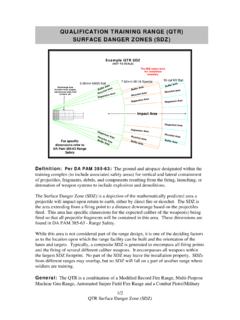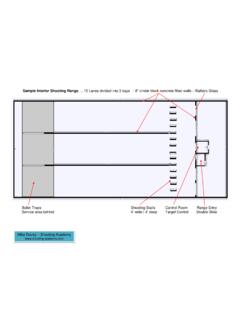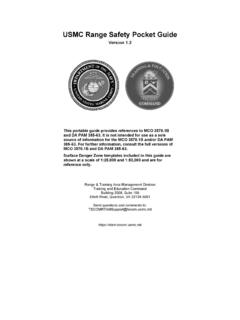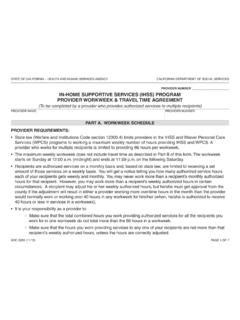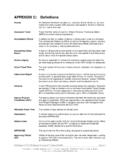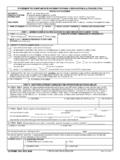Transcription of LOMAH Location Of Miss And Hit - Shooting …
1 LOMAH Location Of miss And Hit What is it? Basically, it s a computerized scoring system for rifle or pistol. In military situations it can also be used with mortars and tanks. A sensor at the target end of the range detects the passage of the projectile through a target and feeds back an X / Y coordinate to a video display screen at the Shooting station. The sensor system is a set of microphones that detect the supersonic boom of the projectile passing overhead. This information is wirelessly transmitted back to the computer at the shooter s side which displays a graphic interpretation of the Location Of the miss And Hit. The target shape is irrelevant it is only the position of the hole that is relayed back to the shooter s monitor. The target can be any shape. There are six microphones that detect the sonic boom of the projectile passing overhead and then relay the X & Y coordinate to the shooter s screen.
2 Shooter s scores are kept and then printed out at the end. (Note: Projectile must be traveling at supersonic speed when it passes over the LOMAH See Appendix for suitable ammunition) The target shape can have a shock-sensor glued to it; when the sensor is activated / vibrated, the Lifter can lower the target for a short time (programmed in), then raise it back up, independent of the LOMAH sensing. Scenarios can be built in to the software to play various games or sniper practice drills. ( it may take 3 fast hits to kill / lower the target. OR, one to the head and two heart shots to kill the target. The alternative; In competitions, spotters have to go onto the field to spot or mark the hits on the target and relay that information back to the shooter. They would hide behind the protective berm then come round the front to score.)
3 For the shooter to see an approximate score, the spotters would use colored paddles to cover the hits or misses. At long distances there had to be a compromise between the size of the paddle and the accuracy of the hit. Too small a paddle = accuracy, but not visible to the Too large a paddle = very visible to the shooter but it covered a too larger area. Exact score had to be relayed back via telephone etc. In some ranges the targets would be retrieved via cables. There are variations on the LOMAH system, which incorporate reactive targets . Here we have two different, although the same, LOMAH systems. Here is a 6 microphone system (Suis Acor) Another 6 microphone system (Theissen Training). Behind each BAR is a target lifter system, both unnecessary to the LOMAH operation.
4 As a projectile passes over the listening microphones, it generates a sonic boom that is detected by the system. The X/Y coordinates are calculated, and if the hit position is within the target defined outline, the lifters drop the target flat, to simulate a hit. (The projectile doesn t knock the target down, the computer does and upon control, puts it back up.) . Y axis X axis Further, the LOMAR system is It can record multiple shots in quick succession, even from a machine gun. (These systems are in extensive military use.) So, the target lifter is really a glorified target. (For those on a budget, somewhat unnecessary.) So how do we define our target? .. Software. If we take a LOMAH bar and lay it on the ground, we can then set a target frame behind it, holding a sheet of cardboard (3 x 3 ) with a Bulls-Eye target painted or stuck to Concrete blocks will be positioned behind the LOMAH bar.
5 The target sheet will be mounted on 2 x 3 studs forming a frame. The frame will then drop into the concrete blocks for support. There needs to be a fixed relationship between LOMAH and target so that replacing target frames can be easily achieved without disturbing their relationship to each other. (A steel frame can easily be built.) The initial setup requires matching the target shape and position to the LOMAH bar and the computer image. A laser registration device is used to achieve this feeding its readings back to the control computer. An image of the target is imbedded into the software. Once calibrated, the computer remembers the target form and the user / shooter can select what shape he is Shooting at. A library of targets and images can be stored. Once the library is built (1, 5, 20, 100 target shapes), there is no need to set up the system each time.
6 On the video, the background target is manipulated to lineup with the three red lines matching the target. Any shape or form can be used as a target. Obviously, the lifter system gives some reality to the Shooting experience, to see a terrorist or animal fall over when hit, but this can also be embedded into the Video monitor software to give the same visual effect, but at the video end instead of the target end. As the lifter unit is prices around $3500 that could purchase a lot of ammo. This system is being installed at the BSA Jamboree site in WV. Because the high caliber rifle is Shooting across a deep ravine, it would be impossible to go out to the target to score or retrieve the paper targets. This system makes it very easy to score, ensures a faster throughput of shooters (there is no stop Shooting while targets are retrieved) and it ensures a much safer Shooting environment with all shooters behind the firing line.
7 For private use, the client has the luxury of being able to shoot continuously regardless of weather conditions, and there is no need to have a target scorer at the target end to report scores back to the shooter. You can shoot continuously without having to retrieve targets or have a scorer / spotter present. (I guess it s more fun with a partner than Shooting alone though.) With continual Shooting possible, I d recommend the Lead-Sled shown later. Just take a photograph of the image and scan it into the computer, using the software provided. Using the editing software, just draw around the target shape and assign scores to various areas. All the LOMAH system does is to record X & Y hit positions and relate them back to the computer, which in turn, translates them onto the image on the video display as Hits or Misses. For a club environment or with multiple Shooting positions, there could be an overlap from one shooter encroaching on another shooter s target.
8 (8 window at 300 yards?) To manage this, the system comes with an optional Lane Discriminator . This is a unit (bar), in a way similar to the LOMAH bar, but it lies in front of the shooter beneath the barrel of the gun. When the shooter fires a shot, the lane discriminator detects the projectile leaving the barrel and opens the LOMAH listening device for a short period of time (1/4 second 2 seconds), determined by the shooter at setup time when the target distance is fed into the software. This opens the sensing microphones for a period of time to allow the bullet to leave the barrel, travel the distance then pass over the LOMAH bar. The LOMAR then closes. This more or less cancels out any shots from neighboring shooter s errant or lousy shots. The video unit reports registering a hit but colors the dot different and gives an error message.
9 If you get a lot, someone is Shooting at the wrong The LOMAH system also has a feature that lets a shooter know if he totally missed the target area. it records the correct shooter s hit (verified by the lane discriminator), but the sonic boom was detected way-off the target area. If this happens an arrow is displayed on the screen, relaying Somewhere over there. You don t want too many of those! The combination of using a LOMAR system, the Caldwell Lead-Sled FCX and the Beretta SAKO TRG .308 fitted with a Burris Eliminator scope Federal Premium 168gr Sierra Gold Medal Match I ve had extreme accuracy and a lot of and gone through a lot of ammo. There are several components making up the Target Reporting System 1: Reporting Video (Receiver) 2: LOMAH detection bar (Scorer and transmitter) 3: Target Reactor (Raising and Lowering Target) 4: Target Registration Frame (Inanimate target holder) Options and Prices: This unit receives data transmitted from the LOMAH system.
10 It represents the information as a dot on the screen, showing where the projectile passed through or near the target, downrange. This unit also controls the target reactor to raise or lower targets when hit, then reset. It can be programmed to alter display times of target edge on, then full face for 3 seconds, then back to edge-on. lay flat, pop up for 4 seconds, then back flat. Giving shoot windows for the shooter. This unit listens for the supersonic boom of the projectile passing over the six microphones. It transmits the X/Y position back to the Reporting Video. This unit is independent of the LOMAR. It raises or lowers the target shape under commands from the computer at the shooter s Reporting Video. There is the option of a shock sensor being glued to the target shape. When the sensor picks up a vibration from a projectile piercing the target, it lowers the target, waits a few seconds, (programmed in), then resets.


